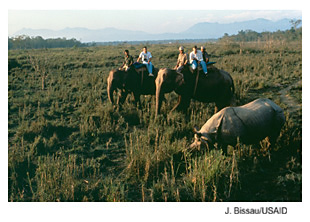Enterprise Development
Economic incentives have long motivated people to exploit natural resources. These same economic incentives can, however, be used to motivate communities to conserve natural resources.
 |
Tourists watch a rhinoceros grazing in India. USAID encourages
sustainable tourism as a way to protect natural resources
while improving local livelihoods. |
Goals of economic development and biodiversity conservation can both be met when communities living in areas with important natural resources and biodiversity adopt income generating activities that are compatible with biodiversity conservation.
Conservationists have recognized that conservation cannot occur at the expense of poor communities in the developing world. As the stewards of their local environment, communities living in and around areas with important biodiversity can and should benefit from these resources. When communities benefit from biodiversity, they are more likely to further ensure its conservation.
One of the more lucrative alternative enterprises is eco-tourism. Communities are increasingly participating in environmentally sustainable tourism ventures. Additional sustainable enterprises involve marketing products made of responsibly harvested wild resources, such as baskets, jewelry, beauty products, or artifacts made of non-timber forest products. Other goods include food products such as jams, jellies, and drinks or pharmaceuticals made from native fruits and plants. Some sustainable enterprises replace conventional crops or cultivation practices with ones that are more biodiversity friendly, such as shade-grown coffee.
USAID has recognized the potential for environmentally sound enterprises to sustain people’s livelihoods while conserving important biodiversity. The Agency is helping communities gain the technical and management skills needed to undertake alternative enterprises, as well as access to credit and markets for their products.
In Kenya, for example, USAID’s Conservation of Resources through Enterprise (CORE) program is working in partnership with the African Wildlife Foundation (AWF), Pact Inc., and the conservation and tourism company, Oryx Ltd, to empower the Koija community to manage an ecotourism operation. The program helped the community build a low-cost, low-impact facility, and trained six community members how to manage the operation. The program also facilitated the development of spin-off enterprises with women’s organizations involved in weaving and beadwork, and a youth organization involved in educating guests about Maasai culture.
More information about USAID’s approach to enterprise development can be found in USAID’s Biodiversity Conservation Guide (6.81MB PDF).
Back to Top ^
|


